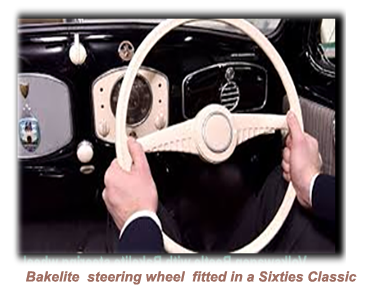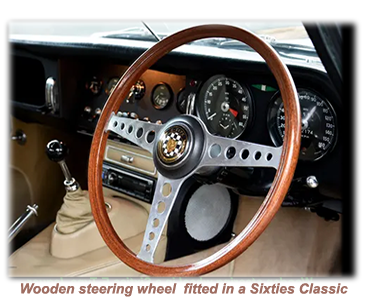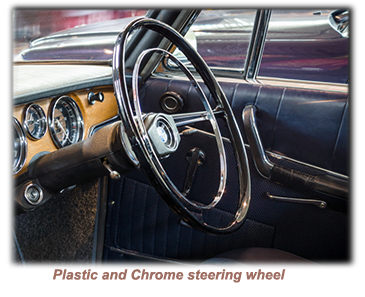 Maintaining a classic car steering wheel can help preserve the integrity and appearance of the vehicle. Here are a few tips on how to properly care for a classic car steering wheel:
Maintaining a classic car steering wheel can help preserve the integrity and appearance of the vehicle. Here are a few tips on how to properly care for a classic car steering wheel:

![]() Leather steering wheels can be treated with a leather conditioner, while plastic steering wheels can be treated with a plastic protectant.
Leather steering wheels can be treated with a leather conditioner, while plastic steering wheels can be treated with a plastic protectant.
 Cleaning the steering wheel on a regular basis is crucial for both hygienic and aesthetic reasons, especially if it is being driven regularly. Since it is the area of any classic that is most frequently touched, the steering wheels will inevitably begin to develop dirt and grime from contact with the driver’s hands over time. A breeding ground for dangerous bacteria, this accumulation of filth and film can even become "sticky" to the touch.
Cleaning the steering wheel on a regular basis is crucial for both hygienic and aesthetic reasons, especially if it is being driven regularly. Since it is the area of any classic that is most frequently touched, the steering wheels will inevitably begin to develop dirt and grime from contact with the driver’s hands over time. A breeding ground for dangerous bacteria, this accumulation of filth and film can even become "sticky" to the touch.
 Cleaning on a regular basis can prevent all of this.
Cleaning on a regular basis can prevent all of this.
 Cleaning and maintaining each of these materials involves a completely different procedure.
Rigid plastic was used to produce steering wheels in the mid-price range bracket, particularly during the Sixties.
Cleaning and maintaining each of these materials involves a completely different procedure.
Rigid plastic was used to produce steering wheels in the mid-price range bracket, particularly during the Sixties.
 These steering wheels, designed and produced to meet the demands of the mass market, very rarely get damaged and are remarkably simple to maintain. All that is required is soap, water, and clean cloth.
A lot of sports tourers produced during the Fifties and Sixties were fitted with wooden steering wheels. Wooden steering wheels are less robust than plastic and require more in the way of maintenance.
As a rule, always keep an eye out for wear, cracks or any other visible damage to a wooden steering wheel and address it as soon as possible, as maintaining it can be the difference between keeping your car showroom ready or otherwise.
These steering wheels, designed and produced to meet the demands of the mass market, very rarely get damaged and are remarkably simple to maintain. All that is required is soap, water, and clean cloth.
A lot of sports tourers produced during the Fifties and Sixties were fitted with wooden steering wheels. Wooden steering wheels are less robust than plastic and require more in the way of maintenance.
As a rule, always keep an eye out for wear, cracks or any other visible damage to a wooden steering wheel and address it as soon as possible, as maintaining it can be the difference between keeping your car showroom ready or otherwise.
int4


